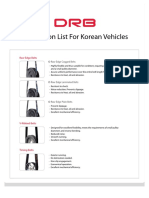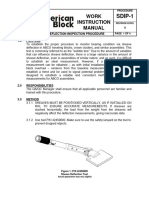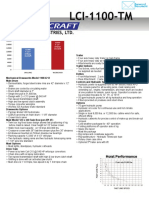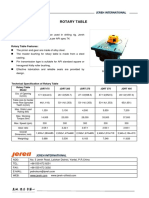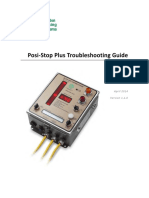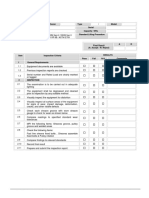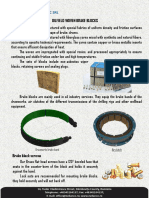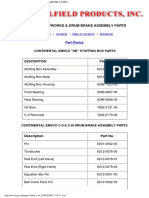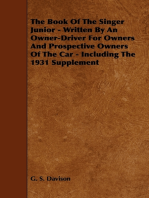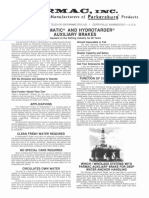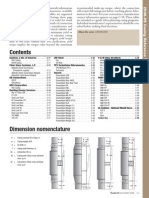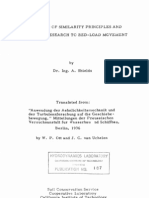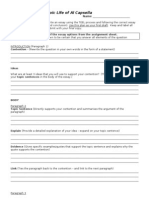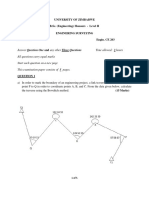Datasheet 836
Datasheet 836
Uploaded by
Timothy PopikCopyright:
Available Formats
Datasheet 836
Datasheet 836
Uploaded by
Timothy PopikOriginal Description:
Original Title
Copyright
Available Formats
Share this document
Did you find this document useful?
Is this content inappropriate?
Copyright:
Available Formats
Datasheet 836
Datasheet 836
Uploaded by
Timothy PopikCopyright:
Available Formats
5358
Manufacturers of P a r k e r s b u rq Products
(316)251-5000
P.O. BOX1149 / TELEX 437 000 PARMACCFVL-UD / COFFEYVILLE, KANSAS 67337 U. S. A.
HYDROMATIC AND HYDROTARDER
AUXILIARY BRAKES
Standard of the Drilling Industry for 60 Years
The Hydromatic Brake or Hydrotarder is a hydro-dynamic device
that absorbs power by converting mechanical energy into heat in its
working fluid which is normally water. Resistance is created exclusively
by fluid friction and agitation of the fluid circulated between the vaned
pockets of the rotor and stator elements with the conversion of
mechanical energy to heat taking place directly within the fluid itself. The
amount of mechanical energy that can be absorbed in this manner is
dependent upon the quantity and velocity of the fluid in the working
chamber.
It will be readily seen that with any specific quantity of fluid in the
working chamber, the velocity of the fluid will be increased with
increased revolving speed of the rotor. In this manner the horsepower
capacity of the Hydromatic Brake or Hydrotarder increases
approximately in proportion to the cube of the speed; if the speed is
doubled, the horsepower resistance is increased eight times. The
hydraulic horsepower capacity increases at this rate to the maximum
operating speed of the brake. It should be noted, however, that other
limitations such as shaft diameter and fluid flow capacity may be the
limiting factor instead of speed.
Still the Simplest and Easiest to Operate
The new and improved Hydromatic Brakes are as easy and simple to
operate as ever. Any Driller can operate them without previous
experience or special training. All that needs to be done is to open or
close the valve that controls the water level in the brake circulating
system.
Now Further Ahead Than Ever
Today's Hydromatic Brakes are the result of years of continuous'
research and improvement. Drillers who have tried them say the new,
improved Hydromatic Brakes are definitely better than ever and still the
best auxiliary drawworks brake ever offered.
APPLICATIONS
The Hydromatic Brake or Hydrotarder is a versatile piece of
equipment. Originally developed for use on heavy duty rotary drilling rigs,
its uses have spread to other areas such as cranes, hoists, ski lifts, on
and off highway vehicles, gravity conveyors, dynamometers, deep water
anchor handling, and many others. Any equipment which generates a
surplus of energy on descent can profit from the smooth, fluid action,
"power absorbing" efficiency of the Hydromatic Brake or
Hydrotarder.
Because of the special nature involved in most other areas, such as
vehicle applications, dynamometers, etc., no attempt has been made to
include detailed information for design in this catalog. It is suggested that
for any proposed application of this nature, our Engineering Department
be contacted.
Almost Impossible to Fail
The new, improved Hydromatic Brakes are practically 100%
failure proof. As long as the water supply to the brake is not interrupted, it
is practically impossible for anything to get out of order in the brake or for
the brake to fail.
Greater Capacity and Safety
The chief improvement in the new Hydromatic Brakes is their
increased capacity. Their greater capacity for handling heavier loads at
lower speeds steps up drilling operations and provides safer working
conditions than ever before.
Ask Your Drawworks Manufacturer
If you are operating a rig without a Hydromatic Brake, or are
considering buying a new rig, ask the manufacturer about installing a
Hydromatic Brake. Manufacturers will be glad to recommend the size
best suited to your needs. All of them know and recommend the
Hydromatic Brake and are prepared to install it before your drawworks
leaves the factory.
FUNCTION OF CIRCULATING SYSTEM
Pressures in excess of those recommended will NOT increase the
resistance capacity of a brake, but will cause rapid wear on the sealing
elements.
Since all of the mechanical energy absorbed in a Hydromatic
Brake appears as heat in the water, it will be apparent that the primary
function of a Hydromatic Brake water circulating system is to supply
cool water through the inlet of the brake to displace the heated water and
thus prevent the formation of steam within the brake; also to remove the
heated water from circulating system or dissipate the heat that is in it.
The secondary function of a Hydromatic Brake water circulating
system is to provide controls to permit the driller to vary the brake
capacity to meet the rig requirements. The capacity at any speed is
adjustable by regulating the quantity of water being circulated between
the vaned pockets of the rotor and stators in the working chamber.
Depending on the type of installation, infinitely close regulation or
regulation in any desired number of steps may be obtained by varying the
rate of flow into the brake or varying the level of the water in the
circulating system and standpipe, dependent on the type of brake and
type of circulating system.
Any circulating system used must include a means for dissipating
the heat from the circulating system at the rate at which it is generated in
the water by the retardation of the brake. Heat dissipation may be
accomplished by the use of heat exchangers, or by providing a sufficient
supply of fluid to act as a heat sink.
CLEAN FRESH WATER REQUIRED
A Hydromatic Brake must have an adequate circulating system
that will provide cool water at all times for the loads that it will be required
to handle. It is imperative that the water used in the circulating system be
fresh and free of all foreign substance. Experience has proven that
brackish or corrosive water, when used in the circulating system, causes
corrosion that accelerates cavitation and erosion within a brake.
NO SPECIAL CARE REQUIRED
When a Hydromatic Brake has been properly installed, it requires
no special care. It should be inspected at regular periods, such as should
be done with the entire rig. Each grease fitting on the brake should be
lubricated with a good grade of No. 2 waterproof grease equivalent on
each round trip before starting in the hole. It is recommended that same
type waterproof grease be used consistently, as some types are not
compatible with others.
CIRCULATES OWN WATER
The rotor in a Hydromatic Brake is also designed to serve as an
impeller for discharging heated water at the discharge ports. The rate of
discharge is approximately the same as the rate at which cool water
enters the brake, provided the discharge line from the brake is not
restricted.
During the running in of a stand of pipe with a Hydromatic Brake
revolving in the direction to create resistance, a sufficient volume of cool
water must be available at the brake inlet, at pressures between the
minimum and maximum recommended, to displace the water in the
brake as it is heated.
WINCH / WINDLASS SYSTEMS WITH
PARMAC AUXILIARY BRAKE FOR DEEP
WATER ANCHOR HANDLING
The Parmac Hydromatic Brake can be used both to control the
lowering of anchors from a work-boat, and to control the anchor chain
payout during the positioning of the anchor from the rig. When used in
conjunction with large anchor handling winches or windlasses, the
power absorbing ability of the Hydromatic Brakes results in better
performance, improved control and smoother operation.
At 200 feet per minute, the Parmac Hydromatic Brakes assist in
safely making the anchor descent rate three times faster than other
equipment being used today.
5359
Manufacturers of P a r k e r s b u rq Products
(316)251-5000
P.O. BOX 1149
TELEX 437 000 PARMACCFVL-UD
COFFEYVILLE, KANSAS 67337 U. S. A.
HYDROMATIC AND HYDROTARDER
AUXILIARY BRAKES
Standard of the Drilling Industry for 60 Years
DISCHARGE
A TYPE FOR EVERY NEED
PORTS
Hydromatic Brakes are available in sizes to meet every need for
drilling to depths well below 35,000 feet and for all sizes of well servicing
rigs. The range of sizes and maximum recommended operating speeds
include the following:
Size
Maximum
Pressure
**
Maximum
Speed
P. S. 1.
R. P. M.
25
25
25
25
25
25
25
15
15
15
15
15
15
15
15
15
15
15
15
2300
2300
2300
1550
1550
1550
1550
1550
900
850
600
600
600
600
375
500
450
480
350
15" D. R.
121
122
22" S. R.
201
202
22" D. R.
V80
S. S. R. 28
262
341
341A
342
342A
60" S. R
451
481
V200
V295
Gallons
Weight of
Brake
Pounds
*
Capacity
Horsepower
6
2
3 1/4
10
5
9 1/10
20
13 1/2
17
30
35
35
56
56
180
78
98
96
315
580
300
432
1200
980
1475
2300
1240
2120
2750
3400
2465
5300
3900
9500
3700
7500
9100
26880
1600
800
1600
2500
1500
3000
4000
5000
5500
6000
6000
6000
7500
7500
8000
8500
9000
10000
12000
Maximum
Shaft Dia.
Inches
3
3
3
4
5
5
4
5
5
5
7
7
7
7
7
7
7
7
9
1/8
1/8
1/8
15/16
15/16
1/2
1/2
1/2
1/2
1/2
1/2
1/2
1/2
1/2
1/4
Volume
In
INLET
PORT
INLET
PORT
Brakes are furnished with special shafts to customer's specifications up
to the maximum shaft diameter shown.
* Based upon maximum possible fluid flowrate thru the brake.
** Based upon maximum rotor R. P. M. and attainable at a flowrate
and horsepower less than maximum.
Parmac's new generation of Hydromatic Brakes are more efficient
for their size and weight. These include the following models: 121, 122,
201, 202, SSR28, 262, 341, 342, 451 and 481.
These newer brakes have an improved sealing arrangement for
better
sealing and
longer
seal life, which also simplifies their
replacement.
Some of these new models offer easier controlability, and will fit in
the old cradle without modification.
When the Hydromatic Brake was first used on drilling rigs for
faster and safer well completion, the rigs were moved by mule teams.
Contractors are now moving rigs by Airplane or Helicopter, and the 341,
342 and 451 are available in Aluminum to meet their low weight
requirements.
When you need auxiliary braking capacity on your rig or semi,
contact Parmac. the Auxiliary Brake People.
Bud McClellan
Frank Nevins
Houston, Texas
(71 3) 956-7400
B. G. Butler
Odessa, Texas
(915)332-6433
Casper, Wyoming
(307) 234-4503
Oklahoma City, Oklahoma
(405)634-1417
Coffeyville, Kansas
(316)251-5000
Larry Taylor
Paul Robben
Bob Fuller
(Sales Mgr.)
Gordon German
Steve Braschler,
(Chief Engineer)
"PARMAC HYDROMATIC
United States Patents "
1,746,372
1,992,910
1,915,547
1,992,911
1,985,889
1,992,912
BRAKES are produced under one or more ol the following
2.061,866
2,113,109
2.126,751
2.170,128
2,786,552
2.287,130
3,016.991
2,733,778
3,860,097
3,945,473
4,043.434
BRAKE SYSTEM is fully protected under the
"The PARKERSBURG HYDROMATIC'
following Foreign Patents."
Argentine Patents 42,776, 204,561, 210,301
French Patents 1,078,520, 75.00279
Venezuelan Patents 1494/33, 34,203,
British Patents 421,807, 422,264, 724,293
34,898, 37,294
1,485,551, 1,571,699
D. R. P. Patent 642,008
Canadian Patents 557,393, 1,030,841,
Italian Patents 499,982, 1,026,328
1,058,053
Australian Patent 491,681
Ned Octrooi, 41246, 42587, 165538
Mexican Patent 138,767
"Other U. S. and Foreign Patents Pending "
"Trademarks HYDROMATIC, HYDROTARDER and PARKERSBURG registered
U S. A. and Foreign Countries "
You might also like
- Manual Top DriveDocument226 pagesManual Top DriveerickNo ratings yet
- SunPak DigiFlash 3000 ManualDocument1 pageSunPak DigiFlash 3000 Manualcharles blairNo ratings yet
- 8026 TorqueMaster Technical SummaryDocument1 page8026 TorqueMaster Technical SummaryGabriela MotaNo ratings yet
- Lubron Bearing SystemsDocument20 pagesLubron Bearing SystemsmasanegraNo ratings yet
- GJ-204-016 Mud Pump 2 & 3 UpgradeDocument6 pagesGJ-204-016 Mud Pump 2 & 3 UpgradeKuna Stanbekov100% (1)
- Dr. Kwon's: Golf Biomechanics Instructor TrainingDocument7 pagesDr. Kwon's: Golf Biomechanics Instructor TrainingBicho0% (1)
- SwivelDocument3 pagesSwivelrodon falathNo ratings yet
- DONGILDocument8 pagesDONGILIvan OmarNo ratings yet
- Utilized Mud Pump Parts ListDocument16 pagesUtilized Mud Pump Parts ListJuan Felipe Garza GNo ratings yet
- HTB1YUPsGpXXXXbhXpXX PRXFXXXBDocument89 pagesHTB1YUPsGpXXXXbhXpXX PRXFXXXBFabio Andres Plata TorresNo ratings yet
- Sheave Deflection Ins ProcedureDocument4 pagesSheave Deflection Ins ProcedureabhilashNo ratings yet
- 201 - CAT3 ABCO - Hook Block (24-Jul-2023)Document17 pages201 - CAT3 ABCO - Hook Block (24-Jul-2023)Angel PerdomoNo ratings yet
- 279D Combination GearboxDocument1 page279D Combination GearboxJorge Vásquez CarreñoNo ratings yet
- Parmac V-80 Brake - Assy # D631538-X - Parts ListDocument3 pagesParmac V-80 Brake - Assy # D631538-X - Parts ListMarcelino Payro TorreNo ratings yet
- HHF-1600 Direct-Drive Pump Utilization Parts ListDocument27 pagesHHF-1600 Direct-Drive Pump Utilization Parts ListJohn Simanca100% (1)
- Centamax Service Life ManualDocument12 pagesCentamax Service Life ManualNajeh BOUIDANo ratings yet
- Handling Tools WebDocument88 pagesHandling Tools WebyelmustafaaliNo ratings yet
- Drill Pipe Handler Operating ManualDocument48 pagesDrill Pipe Handler Operating ManualJose Luis Rodriguez FernandezNo ratings yet
- 12 - 10 E Hoists ADocument6 pages12 - 10 E Hoists AHoang Minh HungNo ratings yet
- Manual Canrig 5Document34 pagesManual Canrig 5sertecs polNo ratings yet
- Back PoshtDocument2 pagesBack Poshtmhn yNo ratings yet
- Roller Kelly BushingRoller Kelly Bushings Heavy Duty Pin Drive Square D...Document4 pagesRoller Kelly BushingRoller Kelly Bushings Heavy Duty Pin Drive Square D...farisNo ratings yet
- HTD SeriesDocument5 pagesHTD SeriesDharmendra khatriNo ratings yet
- LCI 1100SpecSheetDocument11 pagesLCI 1100SpecSheetandy131078No ratings yet
- DG450 Hook User ManualDocument9 pagesDG450 Hook User ManualAhmed MagdNo ratings yet
- English CatalogDocument10 pagesEnglish Catalogcorsini999No ratings yet
- Parts Manual of XJ550 Workover Rig (India)Document153 pagesParts Manual of XJ550 Workover Rig (India)Prajna SatyaNo ratings yet
- Rotary TableDocument1 pageRotary TableAek JayNo ratings yet
- Bowls Bushings AOTDocument2 pagesBowls Bushings AOTcristinelbNo ratings yet
- Composite Rig Control Air Valves CatalogueDocument40 pagesComposite Rig Control Air Valves CatalogueDarshan MakwanaNo ratings yet
- Posi Stop Plus Troubleshooting GuideDocument32 pagesPosi Stop Plus Troubleshooting GuideJesus AristizabalNo ratings yet
- Boot Basket in EnglishDocument2 pagesBoot Basket in Englishyeruar 07No ratings yet
- NYT ZJ40DBST Drilling Rig Gas Detection System Operation ManualDocument12 pagesNYT ZJ40DBST Drilling Rig Gas Detection System Operation ManualJohn SimancaNo ratings yet
- Slip Type Elevator - Shanghai Oilwell Solutions Co., LTDDocument2 pagesSlip Type Elevator - Shanghai Oilwell Solutions Co., LTDHanyNo ratings yet
- IND Drawworks DLS 163Document11 pagesIND Drawworks DLS 163Jose Luis MazzoniNo ratings yet
- 8487A Oilwell A 1100 PT A 850 PT - 881Document8 pages8487A Oilwell A 1100 PT A 850 PT - 881PSC RFQNo ratings yet
- Ection Perating Pecifications: Revision November 2009Document18 pagesEction Perating Pecifications: Revision November 2009Anibal Jose Cruz LarezNo ratings yet
- SWIM Sec.6 / SWIM Sec.3 Api RP 8B / Astm E709Document2 pagesSWIM Sec.6 / SWIM Sec.3 Api RP 8B / Astm E709engmuhmudNo ratings yet
- Arranque de GDSDocument59 pagesArranque de GDSToño ToñoNo ratings yet
- 04 Product Manual PDFDocument9 pages04 Product Manual PDFramiNo ratings yet
- 10P-130 Mud Pump Brochure PDFDocument2 pages10P-130 Mud Pump Brochure PDFprillaNo ratings yet
- Rotary Care & Maintenance Handbook: 2021 Land & OffshoreDocument170 pagesRotary Care & Maintenance Handbook: 2021 Land & OffshoreMohamed RamadanNo ratings yet
- Doc. 20-1715 Rev D (9/12/1005) Pneumatic Spider Operating Procedure ManualDocument12 pagesDoc. 20-1715 Rev D (9/12/1005) Pneumatic Spider Operating Procedure ManualGregory StewartNo ratings yet
- Ton Torque ManometrosDocument16 pagesTon Torque ManometrosEliecer DiazNo ratings yet
- HH SwivelDocument3 pagesHH SwivelHoracio LafuenteNo ratings yet
- Mckissick RJ Style Drilling BlocksDocument1 pageMckissick RJ Style Drilling BlocksRichard EVNo ratings yet
- Drs00750 Rig Bom 1.0Document4 pagesDrs00750 Rig Bom 1.0sertecs polNo ratings yet
- Diese Inserts CatalogDocument48 pagesDiese Inserts CatalogAndres SanchezNo ratings yet
- Mi Swaco MD-3Document12 pagesMi Swaco MD-3solnyshko28110705100% (1)
- FC-FXX - 8 Parts List PDFDocument28 pagesFC-FXX - 8 Parts List PDFjulioramcaNo ratings yet
- Brake Blocks-Evdanco, RomaniaDocument2 pagesBrake Blocks-Evdanco, RomaniacaginmulukNo ratings yet
- Zj704500drigcomponentsspecificationagreement PDF FreeDocument102 pagesZj704500drigcomponentsspecificationagreement PDF FreeH 8CNo ratings yet
- Lewco WH-2214Document9 pagesLewco WH-2214gae muccioNo ratings yet
- Emsco - Drawworks & Drum Brake Assembly PartsDocument2 pagesEmsco - Drawworks & Drum Brake Assembly PartsAhmed EzzeddineNo ratings yet
- RP 3.0 Edition 7 - 2019 FINALDocument17 pagesRP 3.0 Edition 7 - 2019 FINALKevin BryarNo ratings yet
- Tieback Receptacle Polishing MillDocument1 pageTieback Receptacle Polishing MillazimjoonNo ratings yet
- Atwood BeaconDocument2 pagesAtwood BeaconAnonymous yWgZxGW5d100% (1)
- HMH KFDJ Diverters r1Document9 pagesHMH KFDJ Diverters r1budygmoodNo ratings yet
- IDM Basic Training - ModrillDocument30 pagesIDM Basic Training - ModrillThomas Du100% (1)
- The Book of the Singer Junior - Written by an Owner-Driver for Owners and Prospective Owners of the Car - Including the 1931 SupplementFrom EverandThe Book of the Singer Junior - Written by an Owner-Driver for Owners and Prospective Owners of the Car - Including the 1931 SupplementNo ratings yet
- Datasheet 836 PDFDocument2 pagesDatasheet 836 PDFGIAS EUNo ratings yet
- Climbing EssentialsDocument41 pagesClimbing EssentialsTimothy Popik100% (1)
- OIME DrawworksDocument1 pageOIME DrawworksTimothy PopikNo ratings yet
- Fce 3000hp RigDocument6 pagesFce 3000hp RigTimothy PopikNo ratings yet
- Eddy Current Air Cooled Brakes 2Document28 pagesEddy Current Air Cooled Brakes 2Dhen ShuNo ratings yet
- CasingTables 2008Document53 pagesCasingTables 2008Timothy PopikNo ratings yet
- CasingTables 2008Document53 pagesCasingTables 2008Timothy PopikNo ratings yet
- AESCDocument12 pagesAESCtictacalNo ratings yet
- Astronomy Jeopardy Review GameDocument54 pagesAstronomy Jeopardy Review GameJoshua HatchNo ratings yet
- Frictional ForceDocument6 pagesFrictional ForceSherilyn ApostolNo ratings yet
- Application of Similarity Principles and Turbulence Research To Bed-Load Movement - ShieldsDocument47 pagesApplication of Similarity Principles and Turbulence Research To Bed-Load Movement - ShieldsJedd FennerNo ratings yet
- Python Lab 1 - Jupyter NotebookDocument14 pagesPython Lab 1 - Jupyter NotebookWodari HelenaNo ratings yet
- SCP-EX Pressure Sensors: Device FeaturesDocument3 pagesSCP-EX Pressure Sensors: Device FeaturesMahendra Tyre Works RaigarhNo ratings yet
- Process Calculation Rev-1Document18 pagesProcess Calculation Rev-1govindharajalu100% (1)
- Wear Behavior of 100cr6-PolatDocument6 pagesWear Behavior of 100cr6-PolatAntonioNo ratings yet
- Department of Public Works and Highways: DPWH Standard Specification For Carbon Fiber, Item 416Document8 pagesDepartment of Public Works and Highways: DPWH Standard Specification For Carbon Fiber, Item 416jay_medrano_1No ratings yet
- English - Yr 8 - Unit 2 - Resource - Al Capsella - Essay PlanDocument2 pagesEnglish - Yr 8 - Unit 2 - Resource - Al Capsella - Essay PlanBendigo South East CollegeNo ratings yet
- Oil Pump Testing Equipment 7000Document5 pagesOil Pump Testing Equipment 7000Sakthi Sakthi VelNo ratings yet
- Electronics Circuit-2Document2 pagesElectronics Circuit-2vivibabubeNo ratings yet
- GR15Document125 pagesGR15latest advance guruji 2018No ratings yet
- Bone Thickness and Height of The BuccalDocument48 pagesBone Thickness and Height of The BuccalShah VidhiNo ratings yet
- English UEBM001901 PW200 PW220-7KDocument848 pagesEnglish UEBM001901 PW200 PW220-7KMichał BujaraNo ratings yet
- Philo 1 - Week 2Document16 pagesPhilo 1 - Week 2Paule John CliffordNo ratings yet
- University of Zimbabwe B.Sc. (Engineering) Honours - Level II Enginering Surveying MAY 2012 Engin. CE 203Document5 pagesUniversity of Zimbabwe B.Sc. (Engineering) Honours - Level II Enginering Surveying MAY 2012 Engin. CE 203Mercy SimangoNo ratings yet
- Battery Energy Storage System Size Determination 2018 Renewable and SustainaDocument17 pagesBattery Energy Storage System Size Determination 2018 Renewable and Sustainazillur RahmanNo ratings yet
- RAJ SoniDocument40 pagesRAJ SoniPATEL POOJANNo ratings yet
- Pigging in Pipelines.Document14 pagesPigging in Pipelines.john saju malyackalNo ratings yet
- AE510 - 03 NACA 0015 AirfoilDocument25 pagesAE510 - 03 NACA 0015 Airfoilasan09No ratings yet
- MikroElektronika - View Topic - EnC28J60 and PIC18F4550 Ethernet CommunicationDocument7 pagesMikroElektronika - View Topic - EnC28J60 and PIC18F4550 Ethernet CommunicationDanh_IS4No ratings yet
- Installing Virl On Vmware Esxi 5Document12 pagesInstalling Virl On Vmware Esxi 5baraboljaNo ratings yet
- Plant Biochemistry - Lecture Notes, Study Material and Important Questions, AnswersDocument70 pagesPlant Biochemistry - Lecture Notes, Study Material and Important Questions, AnswersM.V. TVNo ratings yet
- MATHEMATICS GRADE 10 Worksheet On Relations and FunctionsDocument1 pageMATHEMATICS GRADE 10 Worksheet On Relations and FunctionszalylyNo ratings yet
- SLAMTEC Mapper Datasheet - M2M2 - v1.1 - enDocument15 pagesSLAMTEC Mapper Datasheet - M2M2 - v1.1 - encodesignerNo ratings yet
- 01-Flame Detection Paper - GPDocument6 pages01-Flame Detection Paper - GPHJNo ratings yet
- Final-Term DSA V1Document3 pagesFinal-Term DSA V1Asadullah Tariq TariqNo ratings yet
- Soal Yang Sering Muncul Di MTCNA MikroTik TestDocument4 pagesSoal Yang Sering Muncul Di MTCNA MikroTik TestSoru-Dara JemivakyNo ratings yet







